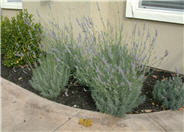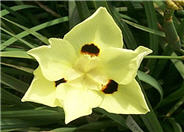
Common name:California Wild Grape
Botanical name:Vitis californica
The California Wild Grape is a woody deciduous vine that with round large leaves. The flowers are in small fragrant blooms and berry clusters appear in the summer. This vine has a sprawling, climbing growth habit. The California wild Grape is native to California and is drought tolerant. It will cover up fences nicely. Grapes are ornamental.

Common name:Hedge Lavender, Lavandin
Botanical name:Lavandula X intermedia
With tall, 24-30" stems, 'Provence' has true, lavender colored flowers that are fragrant and excellent for cutting. It flowers in early June and has large, gray/green leaves.

Common name:New Zealand Flax
Botanical name:Phormium tenax
New Zealand Flax is a large, bold plant with stiffly vertical, sword-like, green leaves that arise from its base. It should be grown under full sun for best color. Varieties will offer different growth habits and leaf color.

Common name:Yellow Moraea, Fortnight Lily
Botanical name:Dietes bicolor
This clumping perennial Iris relative stands 3'-4' high. It has light yellow, iris-like flowers with maroon blotches that are about 2" wide. It performs best in full sun and in soil with good drainage.

Common name:Hall's Japanese Honeysuckle
Botanical name:Lonicera japonica 'Halliana'
The 'Halliana' is a vigorous, hardy, climbing vine with deep green, oval leaves and fragrant white flowers that change their color to yellow. It is good as a groundcover or for covering fences. This is a highly combustible plant.
| Designer: Susan McEowen | Wood Patio Structure |
Photographer: GardenSoft |
Soils and Compost:
Practice grass-cycling by leaving short grass clippings on lawns after mowing, so that nutrients and organic matter are returned to the soil.
Water Saving Tip:
Replace turf with groundcovers, trees, and shrubs. If you have areas where no one uses the grass, patches that do not grow well, or a turf area too small to water without runoff, consider replacing the turf with water-efficient landscaping.
Integrated Pest Management:
Develop healthy soil for plants that are vigorous and naturally pest-resistant.
